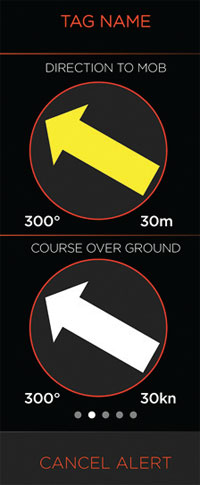

When you do need it you do need it to work
Digital technology has entered every part of our lives and its growing acceptance in the marine safety field means that increasingly these devices and their improving ease of use can literally save lives.
At the forefront of this field is Exposure Marine’s Overboard Location Alert System (OLAS), which allows its users to know instantly when and where someone has gone overboard or out of range and directs the user to initiate retrieval procedures. Without the need for any network signal, this system converts a mobile phone or tablet into an integral part of a boat’s lifesaving equipment.
The way the system operates is simple: OLAS uses a low-energy Bluetooth network which is embedded into Exposure’s proprietary Alert and Find technology. The phone’s app can be paired with a discreet OLAS tag which can be worn like a watch or attached to a lifejacket or throwing object such as a Dan Buoy. The Bluetooth pairing creates a virtual tether to the tag, which is broken when it goes in the water or beyond its working range of 30m.

In normal mode the app screen provides navigation data including course, speed over ground, course over ground, bearing to waypoint and course to steer, as well as a compass. If a tag (wearer) goes overboard, OLAS immediately sounds an alert on the mobile device. The GPS in the device records the exact latitude and longitude where the incident occurred. The crew left onboard then mutes the alarm, and the app screen switches to a large visual arrow (see inset), highlighting the course to steer back to the point the incident occurred. It alerts again when the phone is within a 20m radius of the incident enabling the search and recovery to begin.
Especially for sailors who have never experienced a man overboard (MOB) emergency, or are concerned about exactly what they would do if their most experienced crew goes overboard, OLAS can save vital time and reduce the risk of panic. OLAS provides a reassuring and immediate course to steer back to where the incident occurred. The app also simultaneously steps through making a DSC (distress call) by providing on-screen prompts, including numbers to call, location and time data, and your vessel’s MMSI and call sign. Further prompts remind the user on correct crew overboard procedures at a time when panic can overhwelm even the best training.
The app’s onscreen MOB button can also be operated manually if OLAS tags are not in use. OLAS does not replace a personal PRB or AIS, but it does save time and can work in a multitude of situations.
‘As well as racing on a Fast 40+, I sail with my family and dog on our small wooden cutter. The OLAS works for both situations and offers great confidence for those left onboard should one of the crew fall in,’ says Craig Nutter, professional sailor and family potterer…
Another clever lifesaving device from Exposure Marine is a MOB strobe and searchlight. When every second counts and accuracy is paramount, the Exposure strobe’s motion-activated technology means it can be simply thrown towards a person in the water – its powerful 1,300-lumens strobe will then start flashing within five seconds once the connection is triggered. The burn time is one hour on high mode, five on medium and 20 hours on low. Creating a pool of light in the water and visible for up to five miles, it helps rescue services to locate a person in the water more quickly. Once activated, the MOB light auto-checks the connection every 60 seconds. If the water connection has ceased, it will deactivate to save battery life.
The MOB also doubles as a searchlight, with its high-power spot helping pinpoint an object and provide a periphery beam to illuminate the surrounding area. It offers high output modes for trimming or spotting, and also supplies hours of runtime in lower modes for general use.
Fully buoyant, the MOB strobe is housed in an orange aluminium waterproof casing and is IPX8 rated to 5m. Weighing just 116g, it can fit comfortably in a pocket or be stowed in a lifejacket or wallmounted holster. A fully charged MOB light will remain active for 30 days.
Exposure Lights will supply Dongfeng in the next Volvo Ocean Race and were official suppliers to Abu Dhabi Ocean Racing, overall winners of the previous event.
Abu Dhabi skipper Ian Walker: ‘The MOB is a first class all-in-one torch and safety light. Luckily we did not have to use its MOB capability. However, especially at the speeds we were sailing, it was very reassuring to know we had these MOBs ready to deploy at any time. And the crew love it as a trimming light too.’
Both these devices have proved to be functional and smart – precisely what’s needed in already highly stressed emergency situations at sea.
Click here for more information on Exposure Lights »
We invite you to read on and find out for yourself why Seahorse is the most highly-rated source in the world for anyone who is serious about their racing.
To read on simply SIGN up NOW
Take advantage of our very best subscription offer or order a single copy of this issue of Seahorse.
Online at:
www.seahorse.co.uk/shop and use the code TECH20
Or for iPad simply download the Seahorse App at the iTunes store


